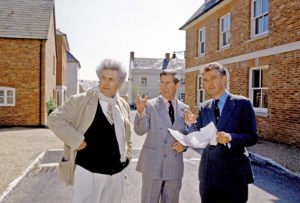“You have, ladies and gentlemen, to give this much to the Luftwaffe: when it knocked down our buildings, it didn’t replace them with anything more offensive than rubble. We did that.” That was the famous barb which the then-Prince Charles aimed at modern architecture in 1987. They were not idle words: thanks to this speech, the architect Richard Rogers lost his opportunity to redesign an area next to St Paul’s cathedral, the 17th-century Baroque masterpiece by Christopher Wren.
It was not the last time the curmudgeonly prince would intervene against Rogers, and nor was it the last time Rogers would have to make room for St Paul’s. His skyscraper on Leadenhall Street, known as The Cheesegrater, owes its slanting profile to rules that protect certain views of Wren’s cathedral.
As we mark the 300th anniversary of Wren’s death, it’s worth noting a certain irony in all of this. St Paul’s may well be the nation’s favourite building, and Wren our greatest architect, but he is more like the grandfather of Richard Rogers than his antithesis.
This will strike some as blasphemous: Rogers’ buildings, which include the Centre Pompidou in Paris and London’s Millennium Dome, are technocratic in the most profound sense of the word. With their machine-like forms and conspicuous feats of engineering, they elevate efficiency and expertise into an idol to be worshipped, a religion in its own right. Impressive as these structures are, one can understand why they would make Charles despair whether “capitalism can have a human face, instead of that of a robot or a word processor”.
But technocratic monuments emerge from technocratic societies, where a fixation with how things work drowns out the question of what they are actually for. The natural and human worlds are treated as processes to be managed, with politics reduced to measurable outputs: higher growth, fewer emissions, a more equal distribution of benefits. Technology is held in awe, but more for its functional qualities than any greater purpose it serves.
This could be a description of our own society, and Rogers’ buildings an honest reflection of it. But these tendencies did not appear from nowhere; they have deep roots in the evolution of modern forms of knowledge and power. And those roots lead us back to Christopher Wren.
Picture the scene: it’s 1656, in a house on Oxford High Street. Three members of what will become the Royal Society, an engine of the scientific revolution, are debating whether poison can be administered directly into the bloodstream. Wren, a 23-year-old Fellow of All Souls College, thinks it can. But how to be sure? One of his accomplices, the pioneering chemist Robert Boyle, duly provides a dog, and the experiment begins. Using various improvised instruments, including a syringe fashioned from a goose quill and pig’s bladder, Wren makes an incision in the panicked dog’s leg, successfully injecting opium into a vein.
This episode was later recognised as the first recorded use of an intravenous anaesthetic. (The drugged dog, Boyle reports, recovered after being whipped around the garden for a while.)
It was experimental science like this that occupied Wren for the first two decades of his adult life, not architecture. He was mainly an astronomer, though he pursued all manner of experiments. He studied Saturn’s rings and the lenses of a horse’s eye; he investigated atmospheric pressure and dissected the human brain; he removed the spleen of a puppy and presented the king with a model of the moon.
This was the birth of modern science, but it was also the critical moment when the question of how began to displace the what and the why. These early scientists were driven by a growing realisation that our intuitions did not grasp the true structure of reality. Their response, at least in England, was to turn away from the philosophical mission of understanding what existence is and what its purpose should be, focusing more narrowly on how natural processes work. Already this shift was reflected in a new emphasis on technology: instruments to measure what the senses could not, and gadgets to show mastery of scientific principles. The patterns of the cosmos were mapped in the objective language of mathematics.
This outlook would eventually lay the ground for the technocratic management of society. And Wren, when he turned to architecture, was very much the technocratic type. Employed as Surveyor of the King’s Works, he was a talented but remote civil servant. After the Great Fire of 1666, his job was to Build Back Better, something he managed very well thanks to his relish for bureaucracy and admin. He even wanted to redesign the City of London in the form of a grid. Wren’s classical style did not reflect a deep connection with artistic tradition; it was, as the historian John Summerson pointed out, a matter of good grammar.
In fact, though Wren designed 56 London churches (of which only 23 remain), his readings of scripture suggest an almost Richard Dawkins-like literalism in regard to religion. He liked to demonstrate how astronomy could explain biblical miracles, and treated Samson’s ability to pull down temples as a maths problem. One of his admiring biographers sums up his mindset perfectly: “How a thing worked — whether that thing was a spleen or a comet, a palace or a government department — was as important to him as the end product.”
What really made Wren tick was impressive engineering, mathematical rigour, and finding the most economic solution to a practical puzzle. This is already evident in his first building, the Sheldonian Theatre in Oxford, where he devised an ingenious system of trusses to cover a lengthy span. His London churches show his love of geometry — “always the True test” of beauty for Wren — as seen in their centralised plans, barrel-vaulted ceilings, and their pursuit of symmetry wherever possible.
It’s not entirely a coincidence, then, that both Christopher Wren and Richard Rogers built domes near the Thames. When Wren proposed this idea for St Paul’s, it was, like Rogers’ fiberglass egg, something alien to London, as well as a state-of-the-art engineering display.
It’s true that Wren’s churches don’t feel overly stringent or rational, and this is a sign of his incredible intellect. Their precise balance of spatial and decorative elements can, at their best, create a sense of serene harmony. Nonetheless, later generations often found an artificial quality in his buildings; one 18th-century poet thought him “extremely odd, / To build a playhouse for the church of God”. It’s difficult to judge his work today because it is now contrasted with a modern architecture that fetishises pure geometry, technology, and the expression of structural principles. Yet these are ideas which Wren himself anticipated.
More than that, Wren and his fellow scientists unleashed a quest for knowledge which eventually created a world so complex it needs technocrats to manage it, as well as architects like Rogers to glorify it. It is a great irony that the designer of Britain’s most beloved cathedral also laid the foundations for a society so starved of spiritual meaning.
Disclaimer
Some of the posts we share are controversial and we do not necessarily agree with them in the whole extend. Sometimes we agree with the content or part of it but we do not agree with the narration or language. Nevertheless we find them somehow interesting, valuable and/or informative or we share them, because we strongly believe in freedom of speech, free press and journalism. We strongly encourage you to have a critical approach to all the content, do your own research and analysis to build your own opinion.
We would be glad to have your feedback.
Source: UnHerd Read the original article here: https://unherd.com/





